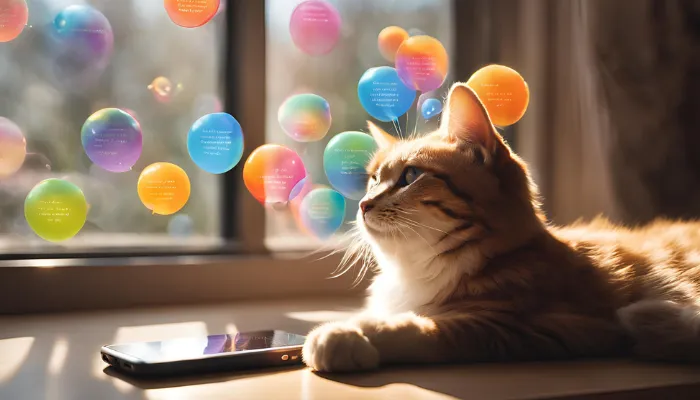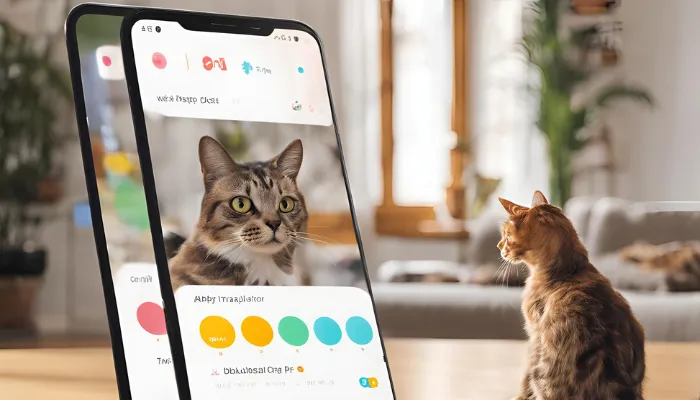Cat Language Translator Tools are transforming how we interact and communicate with cats. They make it possible to us understand meows and purrs on a deeper level. Unlike older models such as cat translator online, these tools use AI to interpret your cat’s sounds and body movements.
With such tools, you will be able to understand when your cat is hungry, ready to play, or just wants some attention. Curious if you can use a cat language translator online to decode your cat’s behavior? Ready to learn what your cat has been wanting you to know all this time? Let’s look at these tools and see how they can strengthen the relationship between you and your pet.

Cat Language Translator: What is it?
A cat language translator or application attempts to translate cat sounds, body movements, and other behaviors into a language that humans can easily comprehend. It’s like having a translation service onboard for your pet. These tools combine audio processing techniques, AI and behavioral analysis to work out what your cat is trying to tell you.
Types of Translators:
- Wearable Devices: Small devices that are attached to the collar of your cat and that are able to listen and analyze all sounds within the vicinity in real-time.
- Mobile Apps: Smartphone applications that record and interpret your cat’s meows. Curious about a cat translator app? They offer a fun, interactive way to decode your cat’s vocalizations.
- Online Tools: Platforms that enable Cat translator users to upload sounds or videos in a variety of formats to be analyzed.
Translators and their fun technologies make it easy to meet and connect with your beloved pets like never before.

How Does a Cat Language Translator Work?
The magic behind a translator lies in its ability to analyze and interpret feline communication. Here’s a step-by-step breakdown of how these tools work:
Step 1: Data Collection
The translator collects data from your cat’s vocalizations (meows, purrs, hisses) and body language (tail movements, ear positions, etc.). This data is either recorded in real-time or uploaded to an online platform.
Step 2: Audio Analysis
Using advanced algorithms, the translator analyzes the pitch, frequency, and duration of your cat’s sounds. For example:
- High-pitched meows often indicate excitement or a request.
- Low-pitched growls may signal discomfort or aggression.
Step 3: Behavioral Interpretation
The tool cross-references the audio data with known feline behaviors. For instance:
- A slow blink might mean your cat is relaxed and trusts you.
- A puffed-up tail could indicate fear or agitation.
Step 4: Translation
Finally, whether through a physical device or a cat language translator online, the analyzed data is converted into a human-readable message, such as “I’m hungry” or “I want to play.” This is where tools like a cat meow translator come in handy, decoding specific vocal cues into understandable meanings.
By combining these steps, cat language translators bridge the gap between humans and their feline companions, making communication clearer and more meaningful.
Science Behind Cat Communication
To truly understand how a cat language translator works, it’s important to explore the science of feline communication. Cats use a combination of vocalizations, body language, and scent marking to express themselves.
Vocalizations
Cats have a wide range of sounds, each with its own meaning:
- Meows: Used primarily to communicate with humans.
- Purrs: Often indicate contentment but can also signal pain or stress.
- Hisses and Growls: Defensive sounds used to ward off threats.
Body Language
A cat’s posture, tail, and ears can reveal a lot about their mood:
- Ears Forward: Curiosity or interest.
- Tail Twitching: Excitement or irritation.
- Arched Back: Fear or aggression.
Scent Marking
Cats use scent glands on their cheeks, paws, and tails to mark territory and communicate with other cats.
Understanding these scientific aspects of cat communication helps decode your feline’s behavior, making it easier to connect and respond to their needs.
An English to Cat Translator helps you communicate with your feline, complementing the Cat Language Translator that decodes their behaviors.

Role of AI in Cat Language Translators
Artificial intelligence plays a crucial role in making translators accurate and reliable. Here’s how AI enhances these tools:
Machine Learning
AI algorithms are trained on vast datasets of cat sounds and behaviors. Over time, they learn to recognize patterns and improve their accuracy.
Natural Language Processing (NLP)
NLP allows the translator to convert complex feline communication into simple, human-readable messages.
Real-Time Analysis
Advanced AI enables real-time interpretation, so you can understand your cat’s needs instantly.
With the power of AI, cat translators are continually evolving, offering more precise and immediate insights into your cat’s unique ways of communicating.
Benefits of Using a Cat Language Translator
A cat translator will make your furry friend’s life better and help you strengthen the bond with your pet.
- Better Understanding: You can easily understand your cat’s meow, purrs, and even their body language.
- Improved Bonding: With the help of the translator, you will be able to respond to your cat’s signals accurately, thereby building trust and affection between both of you.
- Health Monitoring: Changes in vocalizations or behavior patterns help catch early signs of stress, discomfort, or illness quick and easily.
- Reduced Miscommunication: Decrease misunderstandings which cause frustration for both you and your cat by providing yourself an accurate interpretation of their cues.
- Fun and Entertainment: Interacting and “talking” to your cat becomes a funny and entertaining experience. Learning how to speak cat translator style can add an extra layer of fun to your interactions.
- Enhanced Training: The translator helps you expertly guide your cat’s behavior by providing the insights needed for stronger training.
With a cat translator, looking out for your cat’s well-being is easier and strengthening the bond with your feline friend is more enjoyable.
also, Discover how a human to cat translator complements a cat language translator to improve communication with your feline friend.
Limitations of Cat Language Translators
Although cat language translators provide great aspects of cat communication, they have some limitations.
- Accuracy Issues: The tools make use of algorithms, which can misinterpret sounds/behaviors and not provide the most accurate translation possible.
- Individual Differences: Translators might not capture commonly perceived data simply because there are those cats that communicate differently.
- Context Matters: The reality is that a translation can be incomplete or misleading without appreciating the context within which it was uttered.
- Limited to Vocalizations: From a non-verbal identification point of view, numerous translators focus on meows and other sounds to the exclusion of important non-verbal communication like scent marking/ body movements.
- Technological Limitations: Due to the still developing technology, some of the tools might not deliver with real-time analysis or have very few languages to work with.
- Over-Reliance: Users may forget to learn and comprehend the cat’s natural behavior patterns as children that rely solely on these tools to aid them.
While cat translators can be quite beneficial, it is wise to use them only on top of knowing the characteristics of your cat.
Popular Cat Language Translator Tools
If you’re curious to try a cat language translator online, here are some popular options:
| Tool Name | Type | Features |
|---|---|---|
| MeowTalk | Mobile App | Real-time meow translation |
| PurrPlex | Wearable Device | Tracks vocalizations and behavior |
| CatTranslate | Online Platform | Upload audio/video for analysis |
| Kitty Translator | Mobile App | Fun and interactive interface |
These popular cat language translator tools make it easier and more fun to understand your feline friend’s thoughts and feelings.
How to Choose the Right Cat Language Translator?
With so many options available, choosing the right translator can be overwhelming. Are you considering using a cat language translator online? Here are some tips to help you decide:
- Consider Your Needs: Are you looking for real-time translation or just occasional fun?
- Check Reviews: Look for user reviews and ratings to gauge reliability.
- Test Features: Try out free versions or demos before committing.
- Budget: Compare prices and choose a tool that fits your budget.
By considering these factors, you’ll find the perfect cat language translator to enhance communication and strengthen your bond with your furry friend.
Fun Facts About Cat Communication
Using a combination of sounds, movements, and actions, cats have interesting ways to communicate with people and other animals.
- Meows Are for Humans: Unlike the norm of domesticated cats, wild cats do not interact with each other through meowing. This is solely for human engagement.
- Purring Isn’t Just for Happiness: Even when cats are injured or dealing with internal issues, they can be found purring. It is a self soothing reaction for them.
- Tail Talks: Cats with tails straightened or held at an angle with a slight rise indicates cheering, while tremendous tail movement indicates excitement.
- Slow Blinks Are Cat Kisses: The blinking of felines isn’t solely caused from dry or irritated eyes, rather a means for cats to express trust and kinship. For cat owners it’s advisable to blink back as a sign for reciprocating affection.
- Chirps and Trills: Adult cats use these sounds to get the attention of their young ones and they are high-pitched with no accompanying voice. In the presence of humans, they serve as ways of communication.
- The Mystery of Kneading: A cat’s movement of expanding and contracting the forepaws while pressing on softer areas is kitty kneading and it’s done as a soothing mechanism. Catsly, it can mean that the paws are two small to conceal the scent.
- Ears as Mood Indicators: Ears turned forward reveal excitement and restlessness, while ears folded backwards suggest annoyance or fear.
Gaining insights into these lovable traits helps you strengthen your relationship with your cat further and makes your interactions with them so much better!
Conclusion
The Cat Language translator is a revolutionary tool that allows us to interact with our pets. These devices and apps make it possible to interpret our cat’s meow, purrs, and even their body language.
Using a mobile application, cat language translator online, or even a wearable device is an enjoyable activity. Although this technology is not perfect, it does mark impressive progress in communication between people and animals. So, what are you waiting for? Try it for yourself and see the wonders your cat performs for you.
